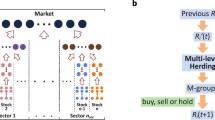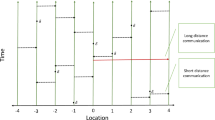Abstract
In this paper, we study herding phenomena of agents in financial markets arising from the combined effect of (1) non-coordinated collective interactions between agents and (2) concurrent reactions of agents to dynamic market signals. By interpreting the expected price of an asset and the favorability on the asset as the position and the velocity in phase space, respectively, we construct an agent-based particle model for explaining herding behavior in finance. We then define two types of herding functionals to this model, and show that they satisfy a Gronwall type estimate and a LaSalle type invariance property, respectively. As a result, we show the herding behavior of the agents. Various numerical tests are presented to numerically verify theoretical results.

Source Tick History provided by Thomson Reuters Datascope Select















Similar content being viewed by others
References
Abreu, D., Brunnermeier, M.K.: Bubbles and crashes. Econometrica 71, 173–204 (2003)
Acebrón, J.A., Bonilla, L.L., Vicente, C.J.P., Ritort, F., Spigler, R.: The Kuramoto model: a simple paradigm for synchronization phenomena. Rev. Mod. Phys. 77(1), 137 (2005)
Ahn, S., Choi, H., Ha, S.-Y., Lee, H.: On collision-avoiding initial configurations to Cucker–Smale type flocking models. Commun. Math. Sci. 10, 625–643 (2012)
Ahn, S., Bae, H.-O., Ha, S.-Y., Kim, Y., Lim, H.: Application of flocking mechanism to the modeling of stochastic volatility. Math. Models Methods Appl. Sci. 23, 1603–1628 (2013)
Avery, C., Zemsky, P.: Multidimensional uncertainty and herd behavior in financial markets. Am. Econ. Rev. 88(4), 724–748 (1998)
Bae, H.-O., Ha, S.-Y., Kim, Y., Lee, S.-H., Lim, H., Yoo, J.: A mathematical model for volatility flocking with a regime switching mechanism in a stock market. Math. Models Methods Appl. Sci. 25, 1299–1335 (2015)
Bae, H.-O., Cho, S.-Y., Kim, J., Yun, S.-B.: A kinetic description for the herding behavior in financial market. J. Stat. Phys (2019). https://doi.org/10.1007/s10955-019-02305-4
Banerjee, A.V.: A simple model of herd behavior. Q. J. Econ. 107, 797–818 (1992)
Barbaro, A.B.T., Taylor, K., Trethewey, P.F., Youseff, L., Birnir, B.: Discrete and continuous models of the dynamics of pelagic fish. Math. Comput. Simul. 79, 3397–3414 (2009)
Bellomo, N., Bellouquid, A., Nieto, J., Soler, J.: Multiscale biological tissue models and flux-limited chemotaxis for multicellular growing systems. Math. Models Methods Appl. Sci. 20, 1179–1207 (2010)
Bellomo, N., Dogbe, C.: On the modeling of traffic and crowds: a survey of models, speculations, and perspectives. SIAM Rev. 53(3), 409–463 (2011)
Bikhchandani, S., Hirshleifer, D., Welch, I.: A theory of fads, fashion, custom and cultural change as informational cascades. J. Polit. Econ. 100, 992–1027 (1992)
Brunnermeier, M.K.: Asset Pricing under Asymmetric. Information Crashes, Technical Analysis and Herding. Oxford University Press on Demand, Bubbles (2001)
Burger, M., Markowich, P., Pietschmann, J.-F.: Continuous limit of a crowd motion and herding model: analysis and numerical simulations. Kinet. Relat. Models 4, 1025–1047 (2011)
Burini, D., De Lillo, S., Gibelli, L.: Collective learning modeling based on the kinetic theory of active particles. Phys. Life Rev. 16, 123–139 (2016)
Carrillo, J.A., Fornasier, M., Rosado, J., Toscani, G.: Asymptotic flocking dynamics for the kinetic Cucker–Smale model. SIAM J. Math. Anal. 42, 218–236 (2010)
Carrillo, J.A., Choi, Y.-P., Mucha, P.B., Peszek, J.: Sharp conditions to avoid collisions in singular Cucker–Smale interactions. Nonlinear Anal. Real World Appl. 37, 317–328 (2017)
Carrillo, J.A., Fornasier, M., Toscani, G., Vecil, F.: Particle, kinetic, and hydrodynamic models of swarming. In: Mathematical Modeling of Collective Behavior in Socio-economic and Life Sciences, pp. 297–336. Birkhäuser, Boston (2010)
Cavagna, A., Cimarelli, A., Giardina, I., Parisi, G., Santagati, R., Stefanini, F., Tavarone, R.: From empirical data to inter-individual interactions: unveiling the rules of collective animal behavior. Math. Models Methods Appl. Sci. 20, 1491–1510 (2010)
Choi, Y.-P., Ha, S.-Y., Li, Z.: Emergent dynamics of the Cucker–Smale flocking model and its variants. Active particles. Vol. 1. Advances in Theory, Models, and Applications. Modeling Simulation Sci. Eng. Technology, pp. 299–331. Birkhäuser/Springer, Cham (2017)
Cucker, F., Smale, S.: Emergent behavior in flocks. IEEE Trans. Autom. Control 52, 852–862 (2007)
Cucker, F., Smale, S.: On the mathematics of emergence. Jpn. J. Math. 2, 197–227 (2007)
Degond, P., Motsch, S.: Continuum limit of self-driven particles with orientation interaction. Math. Models Methods Appl. Sci. 18, 1193–1215 (2008)
Degond, P., Appert-Rolland, C., Moussaid, M., Pettré, J., Theraulaz, G.: A hierarchy of heuristic-based models of crowd dynamics. J. Stat. Phys 152(6), 1033–1068 (2013)
Delitala, M., Lorenzi, T.: A mathematical model for value estimation with public information and herding. Kinet. Relat. Models 7, 29–44 (2014)
D’Orsogna, M.R., Chuang, Y.L., Bertozzi, A.L., Chayes, L.S.: Self-propelled particles with soft-core interactions, patterns, stability, and collapse. Phys. Rev. Lett. 96(10), 104302 (2006)
Devenow, A., Welch, I.: Rational herding in financial economics. Eur. Econ. Rev. 40, 603–615 (1996)
During, B., Jungel, A., Trussardi, L.: A kinetic equation for economic value estimate with irrationality and herding. Kinet. Relat. Models 10, 239–261 (2017)
Ha, S.-Y., Tadmor, E.: From particle to kinetic and hydrodynamic descriptions of flocking. Kinet. Relat. Models 1, 415–435 (2008)
Ha, S.-Y., Liu, J.G.: A simple proof of the Cucker–Smale flocking dynamics and mean-field limit. Commun. Math. Sci. 7, 297–325 (2009)
Ha, S.-Y., Lee, K., Levy, D.: Emergence of time-asymptotic flocking in a stochastic Cucker–Smale system. Commun. Math. Sci. 7, 453–469 (2009)
Ha, S.-Y., Ha, T., Kim, J.-H.: On the complete synchronization of the Kuramoto phase model. Physica D 239(17), 1692–1700 (2010)
Hegselmann, R., Flache, A.: Understanding complex social dynamics: a plea for cellular automata based modelling. J. Artif. Soc. Soc. Simul. 1(3), 1 (1998)
Hemphill, C.S., Suk, J.: The law, culture, and economics of fashion. Stan. L. Rev. 61, 1147–1200 (2009)
Hwang, S., Salmon, M.: Market stress and herding. J. Empir. Financ. 11, 585–616 (2004)
Krause, U.: A discrete nonlinear and non-autonomous model of consensus formation. Commun. Differ. Equ. 2000, 227–236 (2000)
LaSalle, J.P.: Some extensions of Liapunov’s second method. IRE Trans. 7, 520–527 (1960)
Lee, I.H.: Market crashes and informational avalance. The Rev. Econ. Stud. 65, 741–759 (1995)
Marsan, G.A., Bellomo, N., Egidi, M.: Towards a mathematical theory of complex socio-economical systems by functional subsystems representation. Kinet. Relat. Models 1(2), 249–278 (2008)
Merton, R.C., Samuelson, P.A.: Continuous-Time Finance. Blackwell Publishing, New Jersey (1992)
Milgrom, P.R., Stokey, N.: Information, trade and common knowledge. J. Econ. Theory 26, 17–27 (1982)
Motsch, S., Tadmor, E.: A new model for self-organized dynamics and its flocking behavior. J. Stat. Phys. 144, 923–947 (2011)
Naldi, G., Pareschi, L., Toscani, G. (eds.): Mathematical modeling of collective behavior in socio-economic and life sciences. Springer, Berlin (2010)
Pareschi, L., Toscani, G.: Interacting Multiagent Systems: kinetic equations and Monte Carlo methods. Oxford University Press, Oxford (2013)
Santos, M.S., Woodford, M.: Rational asset pricing bubbles. Econometrica 65, 19–57 (1997)
Shiller, C.: Irational exuberance. Princeton University Press, Princeton (2000)
Tirole, J.: On the possibility of speculation under rational expectations. Econometrica 50, 1163–1182 (1982)
Toner, J., Tu, Y.: Flocks, herds, and schools: a quantitative theory of flocking. Phys. Rev. E 58, 4828–4858 (1998)
Toscani, G.: Kinetic models of opinion formation. Commun. Math. Sci. 4, 481–496 (2006)
Vicsek, T., Czirók, A., Ben-Jacob, E., Cohen, I., Shochet, O.: Novel type of phase transition in a system of self-driven particles. Phys. Rev. Lett. 75, 1226–1229 (1995)
Acknowledgements
H.-O. Bae was supported by the Basic Science Research Program through the National Research Foundation of Korea (NRF) funded by the Ministry of Education, Science and Technology (NRF-2018R1D1A1A09082848). S.-B. Yun was supported by the Basic Science Research Program through the National Research Foundation of Korea (NRF) funded by the Ministry of Education, Science and Technology (NRF-2016R1D1A1B03935955). J. Yoo was supported by the Social Science Research Program by (NRF-2017S1A5A8022379).
Author information
Authors and Affiliations
Corresponding author
Additional information
Communicated by Eric A. Carlen.
Publisher's Note
Springer Nature remains neutral with regard to jurisdictional claims in published maps and institutional affiliations.
Rights and permissions
About this article
Cite this article
Bae, HO., Cho, Sy., Lee, Sh. et al. A Particle Model for the Herding Phenomena Induced by Dynamic Market Signals. J Stat Phys 177, 365–398 (2019). https://doi.org/10.1007/s10955-019-02371-8
Received:
Accepted:
Published:
Issue Date:
DOI: https://doi.org/10.1007/s10955-019-02371-8




